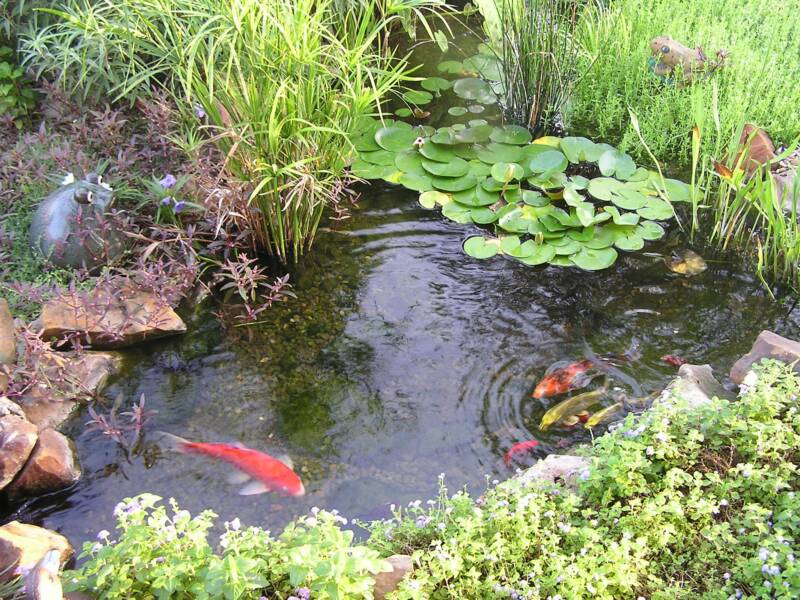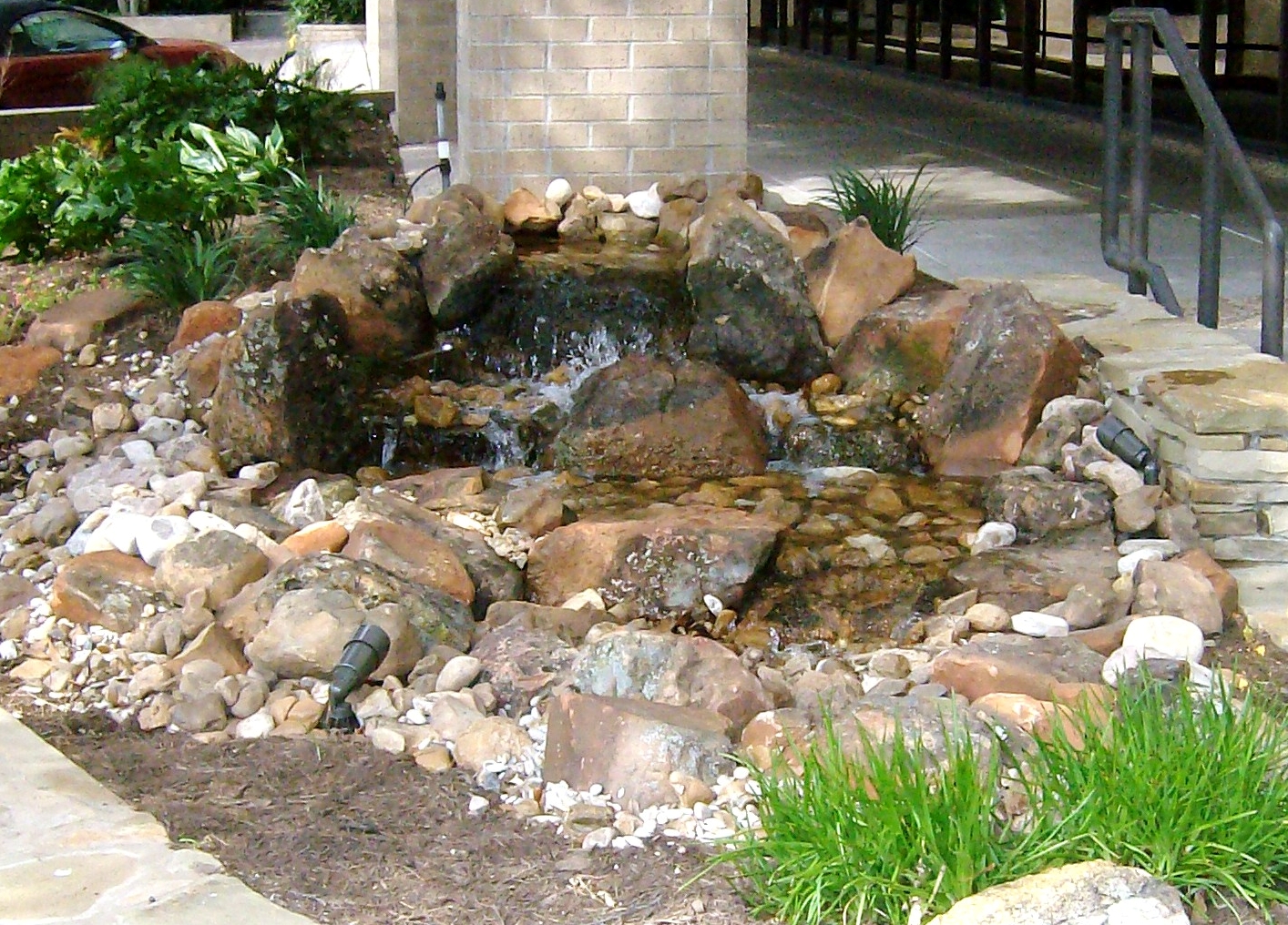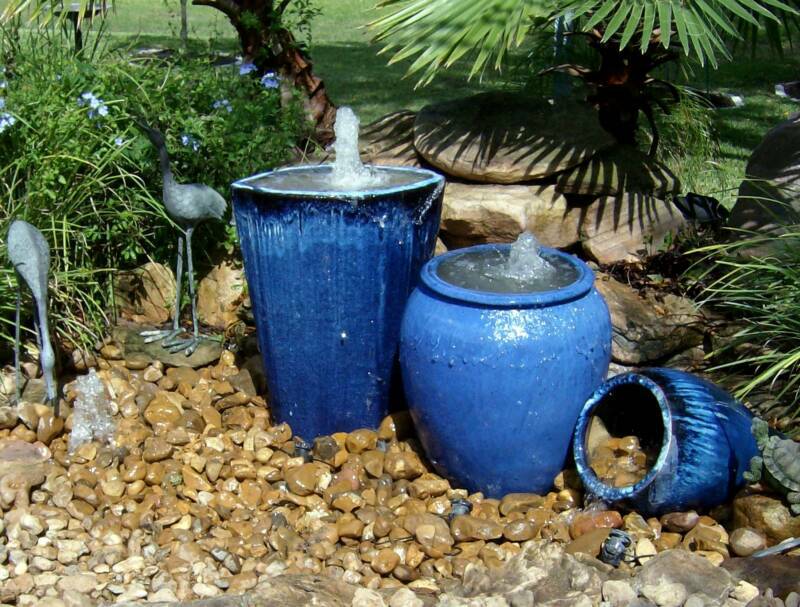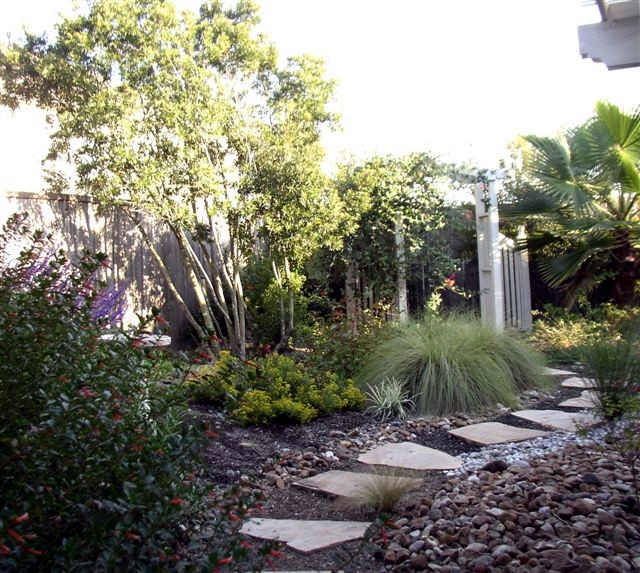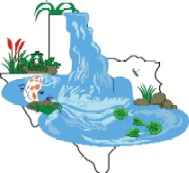


Rainwater Harvesting
Organic Ecosystem Ponds
Pondless Waterfalls
Urn and Fountain Features
Water-Wise Landscapes
Meet Your Water Feature Professionals


Texas Ponds and
Water Features
The Truth About Pond Maintenance
By Matt Boring
the Natural Water Gardener
A well designed water garden becomes the jewel of the landscape in which it’s installed. But like any other garden, it requires a little bit of help from us as gardeners to look and work its best. There is no such thing as a totally maintenance-free pond. However people who own properly constructed ecosystem ponds have much less maintenance to do because we are working with Mother Nature, not against her, and she is working for us to keep our pond ecosystem healthy, clean, and balanced. The beneficial bacteria that colonize the biological filter and the rocks and gravel of the pond constantly work to convert the fish’s waste into nitrates that the plants use for fertilizer. They also compete with the algae for available nutrients in the water, helping to keep the pond clean and the water clear by literally starving the algae away. That being said, there is a little bit you can do through the seasons to give nature that helping hand.
Summers are great for water gardeners. Lilies and other aquatic plants are blooming, filling the yard with color and fragrance. Birds stop to drink and bathe in the stream. Colorful dragonflies flit here and there, consuming large amounts of unwanted insects in the area. Butterflies stop to rest on the flowers. Frogs actually do sit on lily pads, jumping into the water with a splash when you get too close. It’s fun to watch them swim and try to hide in the crystal clear water. Summer nights with the windows open and the frogs singing takes me back to those forgotten summers in the country. The pond needs almost nothing from you all summer. Unless you have a tree that drops its leaves in the summer, there shouldn’t be much in the skimmer to worry about. Like any garden, it helps to pinch off dying blooms and yellow leaves from your aquatic plants once or twice a month. You don’t really want organic material breaking down in the pond, feeding nutrients to the water and it just looks better. Bacteria colonies are strong this time of year, but you might add a pinch every three of four weeks, just to make sure they’re at a good level. Some ponds in full sun may experience a little string algae, but using water lilies and other plants to shade the surface and adding a Koi or two that are 10 inches or longer should clear that right up.
As the days get shorter and the pond water a bit cooler, life in the pond’s ecosystem also slows down. Many of the plants begin shutting down for the winter, storing their nutrients in their root systems. They’ll return next spring, but until then aren’t doing much to remove nutrients from the water. Seeing some string algae form, especially in the waterfall and stream areas, is natural in the late fall. Keeping a little organic barley bale in the BIOFALLS will help cut down on the formation of string algae. There are also some all-natural products that will remove it. However, right now the string algae is our friend, believe it or not. It’s taking out the excess nutrients that the plants are no longer getting and helping prevent suspended algae, leaving your water clear, not bright green. Start adding bacteria once a week and soon these nutrients will be gone and most of the algae will usually be gone too, especially if you don’t feed your fish too much. As the leaves begin to drop, you will have to empty the net or basket in your skimmer. It’s easy enough and takes only a couple of minutes to do. I dump my wet leaves directly into the compost pile. That’s also where I throw dead blooms, lily pads and leaves from the pond plants. They’re a very nutritious addition to your compost.
Once the leaves are through dropping and winter sets in, you usually won’t have to mess with the skimmer much. Cut off any dormant aquatic plants above the waterline and throw a pinch of bacteria in there every week or so and you’re pretty much good to go through the winter. If you feed your fish, slow it down and stop altogether when the water temperature is below 50 degrees. Don’t fall for their little puppy dog eyes trick. They’ll eat it if you give it to ‘em, but in cold water, they can have trouble digesting it and you don’t want to make them sick or worse. If you live in a part of the world that freezes for long periods, you can choose to shut down your waterfall for the season. Just make sure to keep a hole open in the ice for gases to exchange. The fish will ‘hibernate’ at the bottom of the pond and be just fine when it all thaws out. In the south, ours run all the time and many of my aquatic plants stay green all year.
The spring is the time of renewal, of making the garden fresh again to prepare for another year’s life cycle. In the vegetable and flower garden we mix compost into the soil and do other things to prepare for growing season. The organic water garden needs renewing this time of year too. The biological filter should be cleaned once a year to flush out dead bacteria and sediments that may have collected in it. This will enable a fresh new colony of bacteria to establish itself for the upcoming seasons. Every pond is different and some ponds need to be cleaned out each spring. Some can go two or three years or even more without being cleaned. To clean the properly built water garden is simple and should only take 2-3 hours for a couple of people. Critics of natural water gardening say that it’s impossible to clean a pond with rocks and gravel in the bottom of it, but I’m about to let you in on a little secret. All you have to do is get a water garden pump from your local water gardening professional. The one I use pumps around 4000 gallons per hour through a flexible hose and has a screened intake on the bottom. Place it in the lowest part of the pond. Turn off the pump in your skimmer. Remove the filtration media from the skimmer and biological filter and spread the mats out on the lawn. Now turn on the pump and use the flexible hose and the high pressure to easily clean the filters on the lawn. When the filters are clean, collect some of the pond water in a holding tank. Continue to pump out water into the lawn, moving the hose around periodically. It’s nutrient rich and a great organic boost to your lawn in the spring. When there’s 6-8 inches of water left, turn off the pump and catch the fish, placing them in the tank, then finish pumping out the water. Grab the water hose and with a high pressure nozzle, wash down the rocks and gravel starting at the highest part of the waterfall and working your way down. When you start, you’ll see the dirt and sediment washing out. Continue washing till the water runs out clean and then move on, pumping the dirty water out as you go. When the pond is clean, pick up any leaves, sticks, acorns, or whatever may have been missed by the skimmer. Use the pump to clean out the biological filter box and re-install the filtration media. You can check and change light bulbs, prune back aquatic plants, and redistribute gravel that the Koi have moved while the pond is refilling. Use dechlorinator to lock up the chlorine and make the water safe for the fish. Add some dechlorinated water from the pond to the holding tank slowly till the temperatures is about the same in both. Turn on your waterfall and gently release your fish. You’ve cleaned the water garden and watered and fertilized the lawn and other parts of your garden.
Then you just relax, add some bacteria, and let nature do its thing for another year. Sounds far better than hand-scooping 6 inches of fish waste per year out of a slick black liner pond. Mother Nature will take good care of your garden and your water garden too with only a little bit of help from you. Till next month............Happy Pondering!

